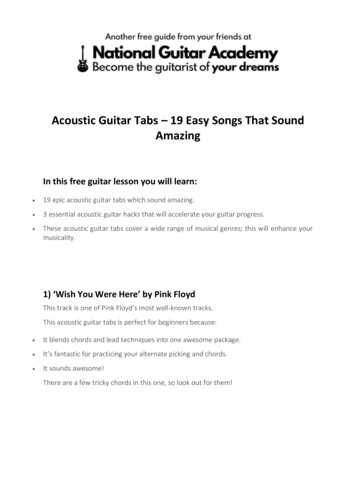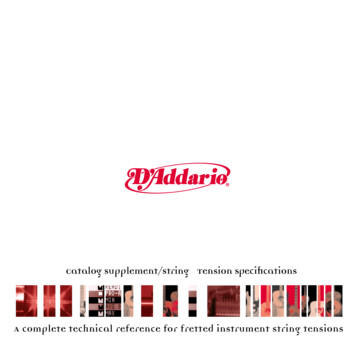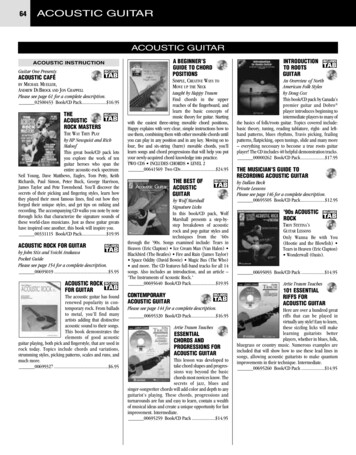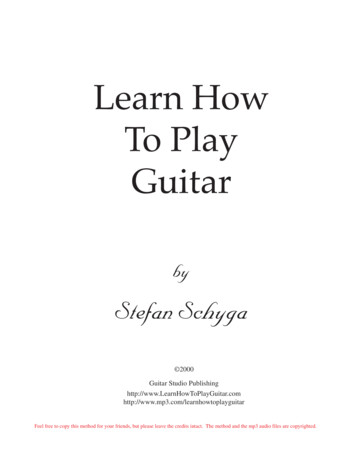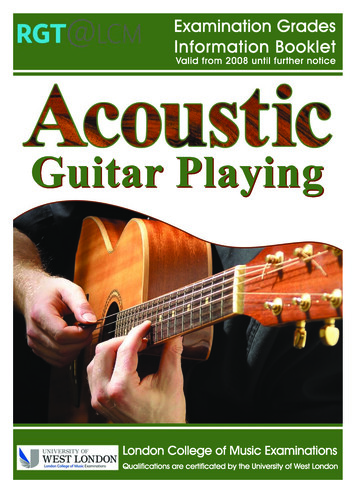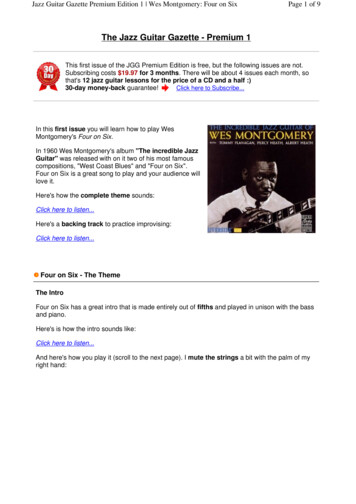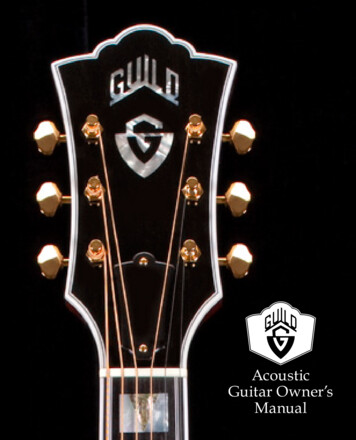
Transcription
AcousticGuitar Owner’sManual
Thank You. for choosing a Guild acousticContentsguitar, an instrument that will giveyou many years of pleasure. PleaseWhen the Craft Matters4take a few moments to read throughMoisture Content and Humidity7Cracks in the Wood8Finish Checking8Neck Resets8General Maintenance9Tuning Machines10Tuning Six-String Guitars10Tuning 12-String Guitars13Changing Strings14Truss Rod Adjustment16Action Adjustment17Travelling With Your Guitar19Limited Lifetime Warranty20Servicing Your Guitar23this booklet—in it you will findvaluable information about care andmaintenance for your guitar, andanswers to many of your questions.
The name itself, “Guild,” came fromthe master craft guilds of the MiddleAges, which only the most highlyskilled craftsmen were permitted tojoin. Today’s Guild guitars reflect thatsame devotion to excellence, with fineacoustic instruments that express thehighest standards of artistry in woodcraftsmanship and guitar making.Now as always, Guild guitars arefashioned from hand-selected woodschosen by discerning buyers who travelthe world in search of them.Guild’s Commitmentto CraftsmanshipMusician and instrument retailer AlfredDronge (1911-1972) founded Guild inNew York in 1952. The first guitars fromhis small workshop were handmadewith expensive rare woods, costlyToday, Guild guitars are stillhandmade, and quality, innovation andservice are still the paramount goals ofthe entire Guild staff. Taking extremepride in every feature of every guitar,Guild and all its artisans are confidentthat you’ll share this pride—in theownership of your new guitar.lacquers and the thorough attentionto detail that could only come froman experienced musician. New Yorkwas home to most of the nation’s topjazz, studio and touring guitarists, andDronge and his staff always listenedcarefully to their suggestions.45
Moisture Contentand HumidityBecause wood is organic and porous,it is affected dimensionally bychanges in the amount of moisture itcontains. Solid-wood guitars are moresusceptible to the effects of changes inhumidity than laminated instrumentsare, and therefore require ongoingattention to their condition.Protection FromTemperature and HumidityIndeed, the greatest natural threatsto a fine wood guitar are extremesof and rapid changes in temperatureand humidity. High humidity cansoften the glues used in building aninstrument, and can cause the top andback (especially on flat-top and classicalguitars) to expand and rise—raisingstring action too high. Or, if you live ina drier, low-humidity climate (hot orcold) or travel with your guitar to one,evaporation of moisture from the woodcan cause shrinking and cracking. Thiscan happen no matter how old the woodis, and string action can become toolow if the top and back shrink enough.F (21.1 C). The ideal humidity is about40 to 50 percent. In winter, the heatingsystems used in many homes candrive temperatures up and humiditylevels dangerously low for guitars. Agood way to protect your guitar fromdrying out is to use a room humidifier.When an instrument is not in use,it should be kept it in its case alongwith a small guitar humidifier (ofwhich many are available). Do notleave a guitar out for long periodsnear a heating vent, radiator or otherheat source; do not leave it exposedto direct sunlight; and do not leave itin a car for long periods. The generalrule is to keep it safe from excessiveheat, cold, humidity and dryness.The ideal temperature for solid-woodacoustic guitars is in fact normal roomtemperature, which is about 70 degrees67
Cracks in the WoodCracks in the wood are typicallycaused by changes in temperatureand humidity. Although initiallyalarming, wood cracks are ofteneasily repaired and shouldn’tbe cause for undue concern ifaddressed promptly and properly.If a crack appears on the top of theguitar near the bridge, loosen thestrings to reduce tension (which canexacerbate the problem) and have thecrack repaired as soon as possible byqualified service personnel.Finish Checking“Finish checking” is a term thatrefers to fine hairline cracks in aninstrument’s finish that run in alldirections. It usually occurs in winterand is often the result of a coldinstrument’s sudden exposure to theshock of warmer temperatures.All the materials that make up aguitar expand and contract withchanges in temperature and humidity.Wood expands as it warms, and doesso faster than its finish. This is whatcauses finish checking, and while itdoesn’t affect an instrument’s tone,it does mar its appearance.8Avoid finish checking by avoidingsudden changes in temperatureand humidity. When bringingan instrument indoors from coldconditions, leave it in its case andallow sufficient time for it to becomeacclimated to a warmer temperaturebefore taking it out of the case.General MaintenanceNeck ResetsFor gloss finishes, use a non-siliconebased guitar polish (many areavailable). For satin finishes, use onlya soft, dry polishing cloth. For handrubbed finishes, use a soft, slightlydamp cloth followed by a dry cloth.Strings exert tremendous tensionand pressure on the woods of anacoustic guitar. Over the lifetime ofthe instrument, in fact, a continuousbattle rages between string tension andwood resistance. Over time and undersuch pressure, the cellulose structure ofwood naturally compresses, which candistort the pitch of the neck. Althoughthis is a natural result of an instrumentadhering to the laws of physics as itages, a neck reset is often necessary tocorrect the problem. It’s not a repairyou can or should do yourself—a neckreset is a specialized procedure thatshould only be performed by qualifiedservice personnel.One of the best ways to maintainan instrument is to keep it clean.After each use, clean a guitar bywiping the fingerboard, stringsand other parts (tuners, pickguard,etc.) with a soft, dry cloth.When not playing an instrument,keep it tuned to pitch and in its case.When storing the instrument for longperiods, however, slightly loosen (butdo not remove) the strings to relievefull tension.Rosewood and ebony fingerboardscan dry out and shrink with decreasesin their natural oils, leaving roughand exposed fret ends on either sideof the fingerboard (“fret sprout”).It’s a good idea to periodically rehydrate a dry fingerboard with rawlinseed oil, which can help preserveits integrity and natural beauty. Afterremoving the strings, apply the oilto a clean, lint-free cloth and rub itinto the wood. Let the oil soak inbefore wiping away any excess.Be careful when using guitar straps,stands and wall hangers made withvinyl, plastic, synthetic leather andsurgical rubber tubing, as thesematerials can react adversely withcertain instrument finishes.9
Tuning MachinesTuning Six-String GuitarsGuild uses fine open-back and die-casttuning machines. Open-back tuners arepre-lubricated, but may occasionallyrequire a small drop of light machine oilon the worm gear (wipe off any excess)and an occasional turn of a screwdriverto make sure that the ring gear centerscrew is snug. Die-cast tuning machinesare sealed and require no lubrication.There‘s more than one way to tune aguitar. Electronic chromatic tuners areplentiful, inexpensive and very easyto use. Simply plug in your guitar andtune the strings from low to high asnoted on the tuner (E A D G B E).A small tension-adjustment screw atthe end of each tuner button holdsthe button in place. If the tension istoo loose, the tuning machine mayslip and go out of tune easily; if it’stoo tight, the button may becomedifficult to turn. Make sure that theadjustment is firm, but not too tight.Acids and oils from the hands candegrade the plating on Guild tuningmachines. Wipe the machines with asoft, dry cloth after each use to preservetheir appearance and function.Strings that are improperly secured totuning machine posts can easily slipand go out of tune. This is commonlymisdiagnosed as a problem with thetuners themselves, so check yourstring installation carefully (seeillustrations 1, 2 and 3 on page 15).10Always tune up to the correct pitchfrom below instead of down to thecorrect pitch from above. This helpseliminate string slack and lessens thepossibility of string slippage whileyou’re playing.To tune a guitar using a tuner withan A-440 reference tone, a guitarpitch pipe, an A-440 tuning fork orother pitch reference, tune the secondstring (A) to pitch accordingly. Thenfret the tuned A string at the 5th fretto produce a D, and tune the adjacentopen D string to that pitch. Continuein this fashion by fretting the tunedD string at the 5th fret to produce a Gand tuning the adjacent open G stringto that pitch; then fret the tuned Gstring at the 4th fret to produce a B andtune the adjacent open B string to thatpitch; then fret the tuned B string atthe 5th fret to produce an E and tunethe adjacent high E string to that pitch.Finally, fret the low E string at thefifth fret and tune it up until its pitchmatches the adjacent open A string.11
Tuning 12-String GuitarsA 12-string guitar exerts atremendous amount of tensionon its neck, which is why Guildsuggests using light-gauge strings.Given the high string tension atstandard pitch, Guild 12-string guitarsshould be monitored regularly for neckwarping and the need for truss rodadjustments. Ignoring these can resultin permanent problems (see page 16).In standard 12-string tuning, thesecond string in each pair is tunedto standard pitch (E A D G B E) justlike a six-string guitar and using thesame methods described previously.For the low E, A, D and G pairs, thefirst string in each pair (the thinnerone) is tuned an octave higher thanits partner. For the B and high E pairs,the strings are tuned in unison.The higher tension caused by sixadditional strings can make frettingnotes and chords on a 12-string guitarmore difficult for some players. Acommon remedy for this is to tunethe entire instrument to a lowerrelative pitch, such as E flat or D,which reduces string tension to amore comfortable level. A capo canthen be used on the first or second fretto achieve standard pitch. Althoughthis reduces tension on the neckand makes the guitar physicallyeasier to play, it also sacrifices asmall amount of tone projection.1213
Changing StringsNew strings will breathe new life intoyour instrument. There’s no set ruleon how often to change strings, butwhile many touring professionalschange them before every performance,most players don’t change stringsnearly as often as they should. Guildrecommends that the average playerchange strings at least once a month.An inappropriate string candamage the neck and bridge. Guildrecommends the following strings fortop performance at standard pitch:Orchestra Guitars:Phosphor Bronze, gauges .012 to .053Grand Orchestra Guitars:Phosphor Bronze, gauges .012 to .053Concert Guitars:Phosphor Bronze, gauges .012 to .053Dreadnought Guitars:Don’t wait until your strings breakto change them. Old, worn, oxidized,pitted and dirty strings will nothold pitch, and they simply soundbad. Humidity, oils and acids fromthe hands, and other contaminantsinteract with the metals in guitarstrings, causing corrosion andbreakdown of the materials.Remove and replace strings one ata time instead of all at once. Thisprevents sudden and potentiallydamaging changes in neck tension.Each new string should be tunedup to correct pitch before the nextone is removed. Always bring abrand-new string up to pitch slowly,as rapid stretching can break it.The gauge and tension of the stringsused on your guitar is critical to itsoptimal performance.14Phosphor Bronze, gauges .013 to .056Jumbo Guitars:Phosphor Bronze, gauges .013 to .056Resonator Guitars:Phosphor Bronze, gauges .013 to .05612-String Dreadnought and Jumbo Guitars:Phosphor Bronze 12-String, gauges .010 to .047Re-StringingTo string a flat-top, remove the oldstrings by unwinding them from thetuners and pulling out the bridgepins. To install a new string, drop theball end into the hole in the bridgeand re-insert the bridge pin with itsgroove positioned over the string. Don’thammer the pin into place; a firm pushwith the thumb is sufficient. Attach theother end of the string to the tuningmachine by threading it throughthe hole in the tuning machine post,running it halfway around the post andthen underneath the main length ofthe string, and then pulling the stringend back over the main length (seeillustrations 1, 2 and 3).Illustration 1String is passed through hole near top ofstring post.Four -String Acoustic Bass Guitars:Phosphor Bronze, gauges .045 to .100Illustration 2String is then wound halfwayaround post.Illustration 3Prevent string slippage byrunning the short end halfwayaround the post, then underneathand back over the main length of thestring before tightening.15
Truss Rod AdjustmentAction AdjustmentString tension exerts tremendousbending force on a guitar neck.Environmental conditions suchas temperature and humidity canalso cause neck bowing. Each Guildguitar has an adjustable truss rod(dual truss rods on 12-string models)running the length of the neck thatcounteracts this force, strengthensthe neck and ensures straightness.String height and tension typicallydetermine the ease with which stringscan be fretted. This description ofplayability is called the “action”and is characterized by the distancebetween the strings and the frets.A truss rod that is too loose will resultin a concave neck bow and actionthat is too high; a truss rod that is tootight will result in a convex neck bow,action that is too low and fret buzz.Depending on the model, truss rodadjustments on Guild guitars are madeeither beneath the truss-rod cover onthe headstock or inside the soundhole atthe other end of the neck. Both requirea 4mm hex wrench. If the adjustmentis at the headstock, the truss rod covermust first be removed with a smallPhillips screwdriver (see illustration 4).Please note: Instruments shouldremain tuned to pitch duringtruss rod adjustments.16Illustration 4If the neck has an excessive concave bowwith high action, tighten the truss rod byturning the wrench clockwise (looking fromthe headstock down the neck toward thebody). If the neck is humped with a convexbow, loosen the truss rod by turning thewrench counterclockwise (looking fromthe soundhole up the neck toward theheadstock). Adjust the rod only a partialturn at a time and allow time for the woodto settle before adjusting again. Sight downthe neck after each adjustment and becareful not to over-tighten the truss rod.Illustration 4 (continued)If you meet excessive resistance or prefernot to make this adjustment yourself, pleasetake your guitar to an Authorized GuildService Center.Depending on your techniqueor playing style, high action cansometimes make a guitar difficultto play, whereas low action cancause string buzz. On flat-top andclassical guitars, action adjustmentsare often delicate procedures thatshould be performed only byqualified service personnel. In theseadjustments, lowering the actionrequires removing the bridge saddle,cutting it down to the appropriateheight and re-installing it; raising theaction involves removing the saddleand replacing it with a higher one.17
Traveling With Your GuitarGuild acoustic guitars are madewith the highest-quality materialsand craftsmanship, and deserveonly the best protection. To providethis protection, a Guild guitar casedesigned and fitted exclusively for yourguitar is recommended. Keep yourguitar in its case when not playing it.When traveling, carry your instrumentin a hard-shell case at all times forprotection. During air travel, guitarsare often exposed to dramatic changesin temperature and pressure. To helpprevent possible damage, de-tunethe strings approximately one wholestep so that the tension on the topand neck is reduced. Guild offersa variety of standard and deluxecases for most guitar models; pleasecontact your local Guild dealer formore information or to place an order.When ordering a Guild case, pleasespecify the exact guitar model.1819
Limited Lifetime WarrantyGUILD INSTRUMENTLIMITED LIFETIME WARRANTYCordoba Music Group (“CMG”)warrants this Guild instrument tobe free from defects in materials andworkmanship for as long as it is ownedby the original retail purchaser, exceptthat pickups, switches, jacks, controls,all other electronic components, tuningmachines, hardware, pickguards,plated surfaces, cases and casehardware are warranted for a periodof one (1) year from the date of originalpurchase. This warranty appliesonly to the original retail purchaserwhen this instrument is purchasedfrom an Authorized Guild Dealerand is subject to the limitations setforth herein. IMPORTANT: PLEASERETAIN YOUR ORIGINAL SALESRECEIPT, AS IT IS YOUR PROOFOF PURCHASE VALIDATING THISLIMITED WARRANTY.CMG has established a network ofindependent Authorized ServiceCenters for warranty service. TheGuild Dealer from whom youpurchased your instrument may alsobe authorized for warranty serviceand should be the first point of contactwhen service of any kind is required20for your Guild instrument. To receivewarranty service, return the completeinstrument to an Authorized CMGService Center, with your sales receiptas proof of purchase, during theapplicable warranty period.Defective components that qualifyfor coverage under this warranty willbe repaired or replaced (at CMG’sdiscretion) without charge. Remediesbeyond normal service repair of anyGuild instrument require both anevaluation and confirmation of thedefect and a direct recommendation toCMG from an Authorized CMG ServiceCenter for alternative considerations.All transportation, insurance andfreight charges associated withwarranty service and repairson Guild instruments are theresponsibility of the purchaser, as isany service initiated for the purposeof customizing setups or adjustmentsbeyond factory specifications. Initialstandard setup and adjustment of theinstrument and its components atthe time of purchase are considerednormal Dealer product preparation,and are not covered by this warranty.Limitations and ExclusionsThe following items are not covered bythis warranty:1. Fret wear, saddle wear, nut wear,strings and batteries.2. Setups, adjustments or routinemaintenance of any kind.3. Damage to finishes or cracks,splitting, or warpage of wood due tochanges in temperature or humidity,exposure to or contact with sun,fire, moisture, perspiration, bodysalts and acids, guitar straps, guitarstands/hangers made from vinyl,plastic, rubber or other syntheticmaterials, any other chemicals ornon-CMG-approved polishes.4. Damage, corrosion or rusting of anyhardware components caused byhumidity, salty air, or exposure tothe moisture, body salts and acids ofperspiration.5. Any damage to an instrumentresulting from customization ormodification.6. Normal wear and tear on anypart of the instrument or caseincluding jacks, controls, switches,plated surfaces, tuning machines,pickguards, handles, latches, casehardware, etc.7. All other damage and deteriorationdue to normal usage, wear and tear,aging, accidents, neglect, abuse, orActs of Nature.8. Any instrument, whose serialnumber is missing, altered ortampered with in any fashion.9. Any instrument purchased fromanyone other than an AuthorizedGuild Dealer.10. Instruments that have been servicedby unauthorized persons (anyperson other than a CMG CertifiedTechnician at an Authorized CMGService Center).THE FOREGOING CONSTITUTESTHE ONLY WARRANTY MADEBY CMG WITH RESPECT TOTHE PRODUCTS AND IS MADEEXPRESSLY IN LIEU OF ALL OTHERWARRANTIES EXPRESS ORIMPLIED. Any implied warranties,including without limitation, anyimplied warranties of merchantabilityor fitness for any particular purpose,imposed under state law are limited tothe duration of this limited warranty.Some states do not allow limitationson how long an implied warranty lasts,so the above limitations may not beapplicable to you.21
CMG ASSUMES NO LIABILITYFOR PROPERTY DAMAGERESULTING FROM FAILURE OFTHIS PRODUCT NOR ANY LOSSOF INCOME, SATISFACTION, ORDAMAGES ARISING FROM THELOSS OF USE OF SAME DUE TODEFECTS OR AVAILABILITYOF SAME DURING SERVICE.NOTE: This warranty applies only toGuild instruments purchased andserviced within the U.S.A. and Canada.Warranties outside these countries areas defined by the authorized CMG/Guild Distributor for your country orregion, and may vary from the above interms and/or length.Servicing Your GuitarNew guitars typically have a settling-inperiod during which adjustments maybe necessary. Many experienced guitarplayers have learned to make their owntruss rod or action adjustments. If youprefer not to make these adjustmentsto your new guitar yourself, bringthe instrument to your nearest Guilddealer or Authorized Guild ServiceCenter for inspection and, if necessary,adjustments. This precaution shouldidentify and prevent potential neckdamage. If major service is required,please contact your local AuthorizedGuild Service Center.To locate Authorized Guild Service Centers,please contact your Guild dealer, visit theGuild website (www.guildguitars.com)or contact the Guild Consumer RelationsDepartment at 1-800-586-1180 orcustomerservice@guildguitars.com.For other support documentation, visitthe “Support” page of the Guild website atwww.guildguitars.com/support.GUILD GUITARS1455 19th St.Santa Monica, CA 90404 USAPhone: 1 310-586-1180www.guildguitars.comWe cannot guarantee top performanceof your instrument if strings other thanGuild, or their equivalent, are used.2223
2014GUILD GUITARS1455 19th St.Santa Monica, CA 90404 USA
acoustic guitar. Over the lifetime of the instrument, in fact, a continuous wood resistance. Over time and under . notes and chords on a 12-string guitar more difficult for some players. A common re
